How To Plan and Keep Track of Your OKRs + 9 Best OKR Software Tools

Objectives and Key Results (OKRs) are quickly taking over our workplaces as businesses look for more effective ways to define and track goals. OKRs are often shared across the organization to create a sense of accountability and collective effort while improving transparency.
One key driver of OKRs' popularity is their ability to align individuals, teams, and even entire organizations around a set of ambitious yet well-defined goals. This is because deciding on OKRs can be a collaborative effort between managers and employees. Everyone is involved in the process, so goals that are beyond the team’s current work level can be set without being overly ambitious to the point of failure.
While they are increasing in popularity and are incredibly useful tools for business, OKRs present several challenges. Since an OKR is designed to be ambitious, it’s easy to get carried away and lose track of what the team is actually working towards. So, businesses need to implement a clear system to manage OKRs and track their progress.

In this guide, we will examine why OKRs are so important, the elements that make up an OKR, each type of OKR, and the best tools you can use to manage them.
TL;DR
OKRs align team and organizational goals, boosting productivity and engagement.
Developed by Andy Grove to replace traditional management practices.
OKRs improve standardization, transparency, and accountability.
Regular updates help in data-driven decision-making.
83% of companies agree OKRs positively impact organizations.
OKRs are highly recommended, with a strong positive impact on businesses.
Key elements of OKR success: Focus, Alignment, Commitment, Tracking, Stretching.
Top OKR tools: airfocus, ProdPad, Lattice, Aha!, Microsoft Viva Goals.
What is an OKR performance management system used for?
Objectives and Key Results (OKRs) are used by businesses to boost continuous learning and create ambitious objectives that will drive growth. Developed by Andy Grove, former Intel CEO, OKRs are a way to manage rapid growth and innovation. They were designed to replace traditional management practices, offering a better way to align and motivate employees toward common objectives.
Here are just some of the ways that OKRs can offer a flexible way to increase productivity and engagement:
Standardization
OKRs improve standardization by establishing clear, measurable goals aligning individual and team efforts with the organization's objectives. This alignment is important as it ensures everyone understands and works towards the same priorities.
Transparency and alignment
The transparency and visibility of OKRs encourage a shared understanding of goals and progress, fostering a culture of accountability and collaboration. Transparency efforts will introduce regular tracking and reviews of OKR progress to provide consistent monitoring and accountability. This ensures that the team is working to the same standards and offers management the chance to identify any issues early.
Monitoring OKRs also allows management to stay aligned. Any problems can be dealt with quickly to ensure everyone remains focused on the same outcomes. This leads to more efficient work processes as teams focus on work that adds value to the product.

Integrating OKRs into daily work
It can be tough for employees to get used to a new way of working, especially new metrics. A great way to ease people into OKRs is to incorporate them into daily work.
Revisiting OKRs in day-to-day activities will help teams make timely adjustments and work with continuous feedback. This will translate into a team that is more agile and responsive to changes, improving overall workflows.
Integrating OKRs into daily work will also build the culture of accountability that is essential for businesses that want to operate smoothly.
Improve focus and engagement
OKRs make teams think about what is truly important when accomplishing a task. It can be easy to get carried away working on a feature that may be nice to include or swept up in working with the same techniques that you’ve always used — but these approaches can come at the cost of your product.
Having the team think of their work based on OKRs means they only focus on what’s most important. This will also improve engagement as employees will think carefully about what will add value to the product rather than getting sidetracked with irrelevant work.
Improve data-driven decision-making
Performing regular updates and reviews of your OKRs will help you prioritize risks, obstacles, and bottlenecks based on their potential impact. This is helpful for data-driven decision-making because you have clear visibility of OKR progress.
Key statistics about OKRs and OKRs in product management
With such a sharp and sudden rise in popularity, many have wondered why OKRs are so important. Let’s briefly look at some statistics explaining why businesses place so much faith in OKRs:
OKRs are being introduced by top management - Mooncamp’s 2022 OKR Impact Report found that 90% of companies said OKRs were introduced by executive management or the board of directors.
OKRs are key change drivers - In the same Mooncamp report, 60% of companies used OKRs to drive change or influence transformation initiatives. Typical uses include improving corporate culture and strategy execution.
OKRs improve communication. - By measuring the number of communication channels used and implementing regular OKR check-ins, Companies can achieve a 28% increase in communication intensity.
OKR coaches are crucial - Over 80% of companies have an OKR coach or similar role. Their job is to oversee and manage the OKR process and ensure teams successfully adopt this new way of working.
OKRs have a real impact on businesses - Businesses that adopt OKRs are highly likely to recommend them to others. Decision makers surveyed by Mooncamp strongly recommend OKRs with a rating of 8.5 on a 10-point scale. 83% of respondents agree, and nearly 1/3 strongly agree that OKRs have had and continue to positively impact the organization.
FAQs
What are OKRs?
Definition of Objectives And Key Results (OKR)
Objectives and Key Results, also known as OKR, is a goal-setting framework used in businesses to align individual performance with overall goals in a measurable way.
OKRs are made up of an objective, which is a clearly defined goal, and one or more key results, which are objective measurements of progress toward the objective.
An OKR should look like this:
Objective: Increase the total number of daily users for our app.
Key Result 1: New user sign-ups increased by 70%.
Key Result 2: Total daily active users increased by 50% month-on-month.
What are the 5 elements of OKRs?
OKR success typically boils down to 5 key elements, often called FACTS. These factors were outlined by John Doerr in his book Measure What Matters in which he lovingly refers to them as “OKR superpowers.” Here’s what each element represents:
Focus - OKRs focus on one goal, and anything that will not contribute towards it should be ignored.
Alignment - As with any project, success can only come when everyone involved works towards the same goals.
Commitment - OKRs are commitments to specific goals that move your business forward. They place accountability on the team and management, which pushes everyone involved to hit the target. OKRs should be decided in a collaborative fashion to ensure they remain realistic.
Tracking - By checking OKR progress frequently, you can see if everything is on track and spot issues early on to avoid derailing progress.
Stretching - While they should still be realistic, teams should choose OKRs that push their boundaries rather than focusing on what they can comfortably achieve.
What are the types of OKR?
There are three types of OKRs that businesses can use to reach organization-level objectives:
Committed OKRs - Committed OKRs are goals that are essential to success. These are the most important OKRs to focus on, and team members should prioritize work that helps them achieve these OKRs within a reasonable timeframe.
Aspirational OKRs - Aspirational OKRs tie in with continuous learning and the need for growth. They are chosen by discussing comfort zones and seeking ways to break out of them. Teams may not hit aspirational OKRs, but coming close to achieving them will have more benefits than focusing on easily achievable targets.
Learning OKRs - Learning OKRs are explorations or experiments that aim to prove a hypothesis. They are best used to test early-stage ideas where the details may not be fully clear, but the idea is still worth pursuing as a primary focus. Writing a successful learning OKR requires the team to identify what information will help you move forward.
What is OKR software?
OKR software, like the airfocus Objectives and OKRs app (part of airfocus product management operating system), are purpose-built tools for managing OKRs. Rather than using a spreadsheet or trying to work around existing tools, OKR software allows users to set and track goals with clear progress reporting. OKR tools that are connected to your product work offer alignment with your strategy and roadmaps and help keep you (and your work) focused.
Why should product managers use a dedicated OKR management tool?
OKR tools will help increase accountability and transparency by presenting OKRs and their progress clearly. OKR Software can also be used to feed into performance reviews. The OKR software will take the information used to track OKRs and create unique insights useful for reviewing team and individual performances. These insights help present learning opportunities for team members and managers alike.
9 of the best OKR software tools
Have we sold you on the benefits of OKR software? If you’re ready to try them out for yourself, here are some of our top picks:
1. airfocus Objectives and OKRs
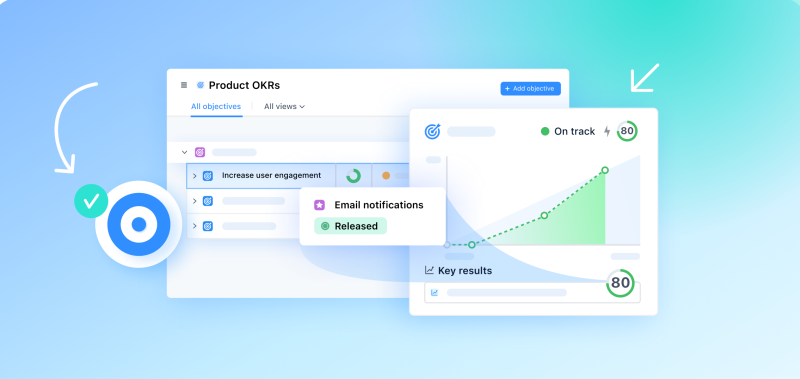
Objectives and OKRs is another great tool from airfocus that helps teams build the best possible products and improve workflows.
With airfocus Objectives and OKRs, you can connect OKRs, roadmaps, and product workflows to ensure team alignment. It also allows you to track the progress of multiple teams and different objectives in one place, from user stories to company-wide transformation initiatives.
Since airfocus Objectives and OKRs seamlessly links with the rest of your airfocus product work, you can link items like epics and tasks to your OKRs. This means you can track OKR progress way more easily than spreadsheets or separate OKR tools allow.
Rating: G2 - 4.4 stars.
Demos: You can have an instant tour on your own or book a demo on the website.
Pricing: Plans start at $59 per editor per month.
Free trial: Yes.
Pros:
Unified product operating system for your products.
Link product work to OKRs.
Real-time insights and check-ins.
Enhance transparency.
Implement any objective management framework.
Can track the progress of multiple teams.
Modular platform, so you only pay for what you use.
Cons:
There might be a little bias involved here, but we will let you know if we find any 😉.
2. ProdPad
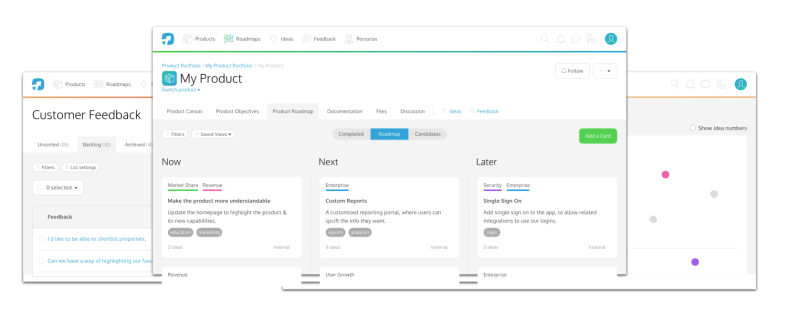
ProdPad touts itself as the first product management tool to have OKRs built in and promises to make it easy to measure the success of your objectives. It allows you to link OKRs directly to your roadmap and improve clarity for your teams.
By building roadmaps around OKRs, Prodpad helps you explain the next steps and what teams are working towards. With three grading statuses, anyone can check progress at a glance to see what’s on track, behind, or at risk. This allows ProdPad users to boost team performance and simplify launches using an object-led workflow that promotes accountability.
Rating: G2 - 4.3 stars.
Demos: You can request a demo on their website.
Pricing: Full OKR management requires Roadmaps Advanced at $44 per editor per month.
Free trial: Yes.
Pros:
OKRs integrate with roadmaps to increase transparency.
Sets clear priorities to help eliminate aimless work.
Focuses on outcome not outputs.
Provides clear communication on strategy and direction.
Offers easy progress tracking to boost accountability.
Cons:
Users are locked into one way of working with limited platform and feature flexibility.
Only allows key results to be linked to roadmap initiatives.
Long stories or roadmaps can be hard to navigate.
Not the most user-friendly platform.
3. Lattice
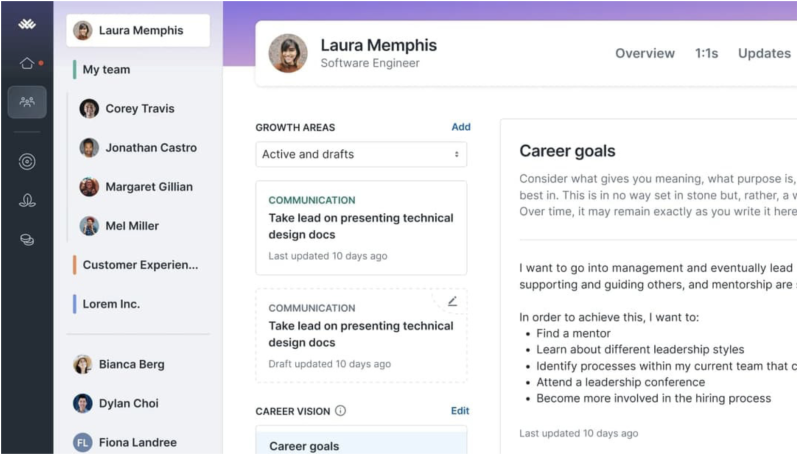
Lattice is a dedicated OKR tool designed with OKRs in mind. The platform is highly user-friendly and brings together all of the tools, workflows, and insights organizations can use to develop and engage their employees.
Lattice offers a centralized platform for defining, tracking, and measuring individual goals that can be linked back to broader organizational objectives. It allows product teams to incorporate OKRs into daily activities such as one-on-one meetings, status updates, and performance check-ins to ensure they constantly influence work. Infusing OKRs into tasks like this helps teams remain aligned with the objective and keeps teams focused.
Lattice also offers onboarding surveys, pulse surveys, engagement surveys, exit interviews, feedback, and year-end reviews on one platform. This allows you to manage people as well as managing projects.
Rating: G2 - 4.7 stars.
Demos: You can request it on their site.
Pricing: Plans start at $11 per user per month.
Free trial: No
Pros:
Incredibly user friendly.
1:1 management.
Combine all OKR-related tools and tracking methods into one platform.
Increase visibility and clarity.
A good amount of integrations.
Cons:
Cannot create agendas for team meetings.
Cannot track progress on projects with multiple teams.
Reports can be limited and require manipulation to create valuable insights.
Lacks customization.
4. Aha!
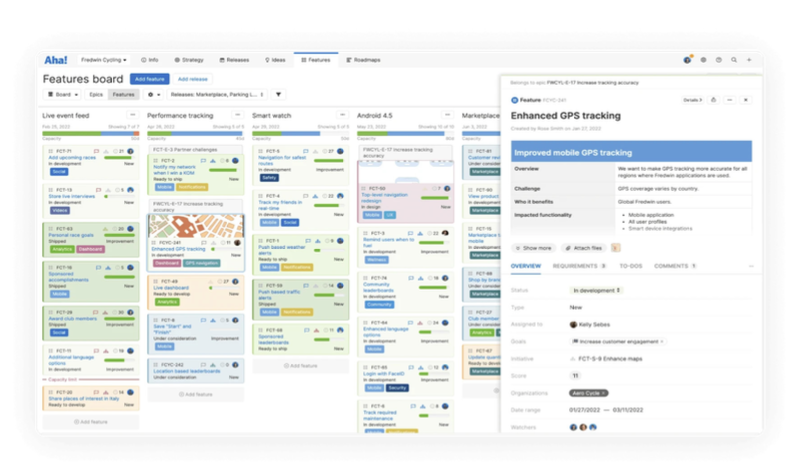
Aha! Roadmaps offer a solution for managing Objectives and Key Results (OKRs) within your product management framework. This software's workspace hierarchy allows you to set objectives at various organizational levels, facilitating a cascading approach to OKR alignment.
Ratings: G2 - 4.3 stars.
Demos: Aha! Roadmaps | Getting Started.
Pricing: Plans start at $59 per user per month.
Free trial: Yes.
Pros:
Allows for basic linking of OKRs and product work.
Enables teams to align their tasks and projects with overarching OKRs.
Can be used within Agile, Lean, or other methodologies.
Cons:
Limited flexibility with predefined fields and layouts.
Operates from the premise that roadmaps are timelines.
The UI can be difficult to understand and navigate.
Combines project and product management into the same discipline.
5. Microsoft Viva Goals
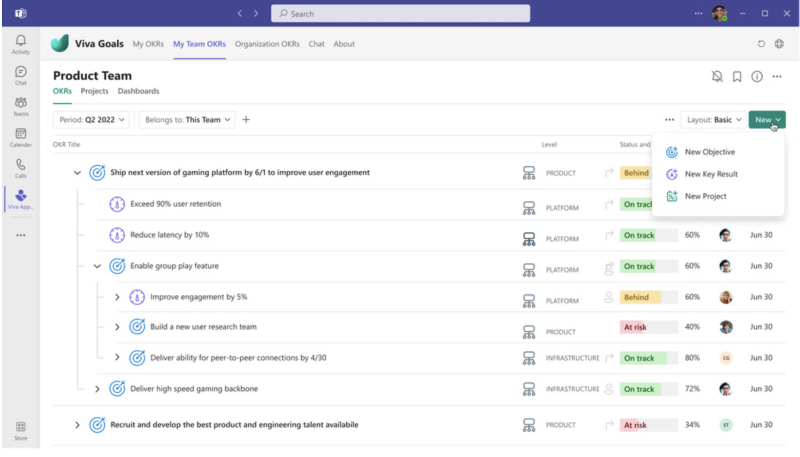
Microsoft Viva Goals is an efficient goal management platform with an intuitive OKR system for streamlined goal setting, tracking, and alignment. It enhances team collaboration and real-time progress monitoring, offering robust analytics for data-driven decision-making and customizable reports. However, there's a learning curve for full utilization.
Rating: G2 - 4.3 stars.
Demos: Not available. Pricing: Pricing starts at $6 per user per month.
Free trial: Yes.
Pros:
Intuitive OKR system.
Enhances team collaboration.
Real-time progress monitoring.
Robust analytics for data-driven decision-making.
Cons:
Learning curve for full utilization.
Limited view options for data.
May require additional effort for full tool integration.
6. Perdoo
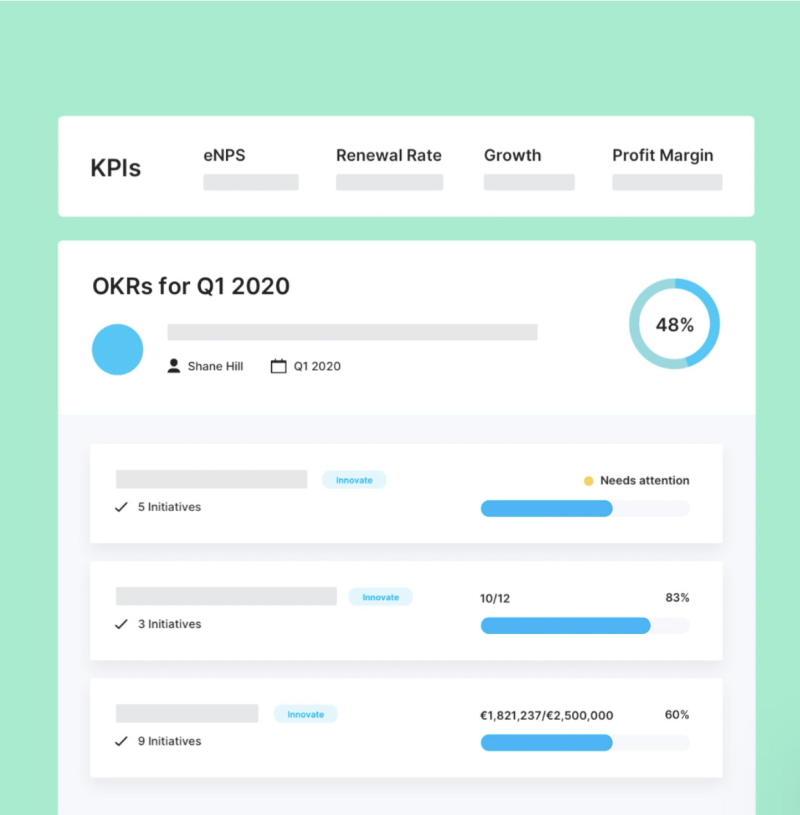
Perdoo is a dedicated OKR tracking tool focused on performance management. It helps set, track, and manage OKRs with custom dashboards, real-time progress tracking, and automated reporting. It has a user-friendly UI, making it easy to align your team’s goals and objectives transparently. However, the learning curve, cost, and feature complexity may be barriers for some teams.
Rating: G2 - 4.2 stars.
Demos: Available upon request on their website.
Pricing: Free for up to 5 users, then prices start at $8 per user per month (billed annually).
Free trial: Yes.
Pros:
Custom dashboards and real-time progress tracking.
Automated reporting.
User-friendly interface.
Transparent goal alignment.
Cons:
Learning curve.
Can be costly.
Feature complexity may be a barrier for some teams.
7. WorkBoard
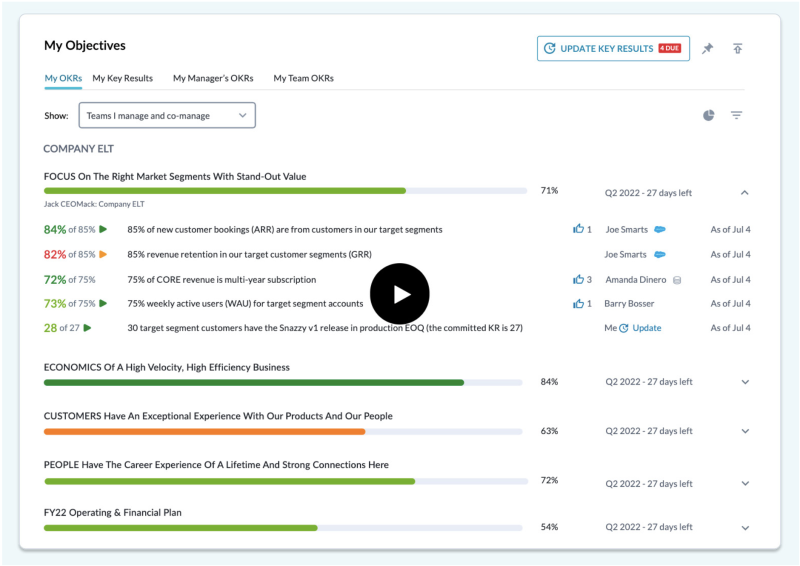
WorkBoard markets itself as “the enterprise standard for OKRs and strategy execution.” It offers a full suite of features to set, align on, track, and communicate OKRs. While pricing information is not accessible on their current website, it’s assumed to be available after signing up for a demo. Some users have commented on it not being very responsive and hard to access support information.
Rating: G2 - 4.7 stars.
Demos: Available upon request on their website.
Pricing: Pricing details are available upon contacting their sales team.
Free trial: Yes.
Pros:
Full suite of OKR features.
Aligns and tracks OKRs.
Promotes strategy execution.
Cons:
Pricing information is not readily accessible.
Some users report responsiveness issues.
Hard to access support information.
8. Mooncamp
Mooncamp positions itself as a versatile and user-friendly OKR management tool designed to drive alignment and focus within organizations. Its intuitive interface makes it easy to invite team members, create or import OKRs, and connect with favorite tools for seamless integration.
Mooncamp’s strategy tree offers a high-level view of the organization’s strategy, mapping out strategic pillars, focus areas, goals, and initiatives on a hierarchical strategy drawing board. Its powerful filters and customizable views allow users to tailor their experience, providing public or private views of goals as cascade, list, or network.
Rating: G2 - 4.8 stars.
Demos: You can request a demo on their website.
Pricing: The essential package starts at EUR 6 per user per month, billed annually.
Free trial: Yes.
Pros:
Highly intuitive and user-friendly interface.
Allows easy editing and bulk operations for efficiency.
Supports public and private views with customizable filters.
Seamless integration with Microsoft Teams and Slack for goal setting and tracking.
Flexible platform allowing extensive customization of properties and goal types.
Cons:
Check-in schedules cannot be accessed from the Teams add-in; browser access is required.
Default user rights allow all employees to change goals; changes only apply to new goals.
Limited ability to create views by "check-in" category or schedule.
Advanced features might require a learning curve for new users.
9. Asana Goals
Asana Goals connects company objectives with the work that supports them, ensuring that teams focus on the right tasks. It allows users to set goals and key results at various levels, aligning them with projects and portfolios for better prioritization and progress tracking.
Asana Goals updates automatically as teams make progress, helping spot blockers in real-time. Users can add and categorize goals, set targets, define teams, plan timelines, and control access. Goals can be linked to larger company objectives, broken into sub-goals, and connected to supporting projects and tasks.
Rating: G2 - 4.4 stars.
Demos: You can request a demo on their website.
Pricing: They have a free forever version for individuals and small teams. Packages start at EUR 10.99 per user per month (billed annually).
Free trial: Yes.
Pros:
Connects company objectives with supporting work to ensure alignment.
Allows setting and tracking of goals and key results at various levels.
Automatically updates goal progress to identify real-time blockers.
Provides customizable views and dashboards for monitoring progress.
Integrates with tools like Salesforce for automatic goal updates.
Cons:
Steep learning curve for new users due to a complex interface.
Limited task assignment to only one person per task, which can be restrictive.
Extensive features may complicate simple projects.
No built-in time tracking feature, requiring third-party integration.
Limited exporting options, with only JSON and CSV formats supported.
Try Objectives and OKRs from airfocus
And that’s that! OKRs are an incredibly useful tool for product management teams if they know how to manage and track them properly. That’s where OKR management tools come in. If you’d like to learn more about how airfocus can help you manage OKRs for better business alignment and success, try out Objectives and OKRs from airfocus today.

Nouran El-Behairy
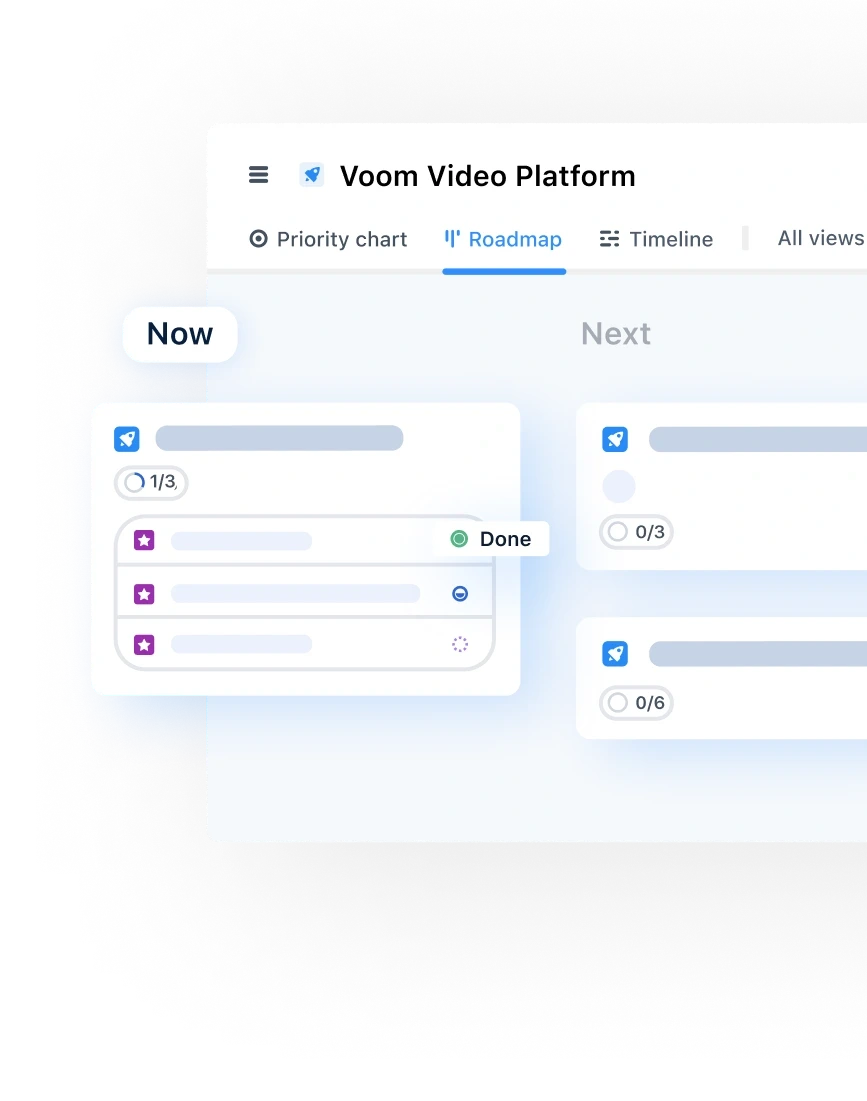
Read also



Create effective product strategy

Experience the new way of doing product management



